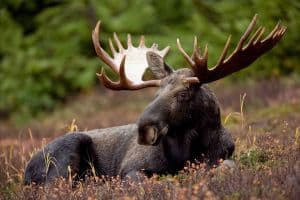
As moose have slowly disappeared from northeastern Minnesota in the past decade, researchers have been undertaking exhausting studies to understand why.
Now, they have a pretty good idea. One quarter to a third of the dead moose they were able to examine died due to brain parasites carried by whitetail deer.
In a report in the Star Tribune, Department of Natural Resources managers explained that deer can carry the parasites without suffering any ill effects. But they can kill or seriously weaken moose.
Deer are native to the southern part of the North American continent, and over hundreds of thousands of years, they evolved to withstand the parasites they carry. Two of those parasites are problematic — brainworm and liver flukes — and both spend part of their lives in slugs and snails. Deer eat the snails and slugs while browsing, and the microscopic brainworms make their way to the outside of the deer’s brain, where they lay the eggs. After hatching, the larvae move through the digestive tract and out in feces, where they are picked up again by snails. Liver flukes start in the liver, but end up back in snails by the same route.
Moose pick them up the same way — by eating snails while browsing. But moose, which are believed to have crossed over from Siberia just 70,000 years ago, have not developed the defense mechanisms that deer have, and the parasites can damage their brains, nervous systems and livers.
With brainworm, moose often develop a characteristic head tilt, and the infected moose are often the ones seen wandering aimlessly where they shouldn’t be — like roads.
While the deer parasites directly kill many moose, they also make them easy prey for wolves. That’s why the researchers believe deer are the biggest cause for the declining moose population.
Deer did not live in northern Minnesota before European immigration in the 1800s. Then, development, logging, and other activities created habitat where deer could survive. Recently, warmer, less snowy winters have helped them thrive in the region. The growing population has also had a significant impact on the types of trees and forests that survive their intense winter browsing.
One University of Minnesota researcher recently turned to the public to help fund a project to better understand the deer-parasite-moose relationship. Dr. Tiffany Wolf successfully raised more than her goal of $6,000 to launch genetic testing that will pinpoint the problem.
“We know that snails and slugs play a role in transmission, but we don’t know which ones are important and when or where moose are consuming the infected gastropods,” the fundraising page said.
By studying the parasite population, Wolf hopes to identify the snails that moose are consuming, and hopefully find new ideas for protecting the animals. She will collect moose feces and test it for the DNA of snails the moose has eaten, and for brainworm DNA. That should indicate which species of snail are transmitting the parasites.

